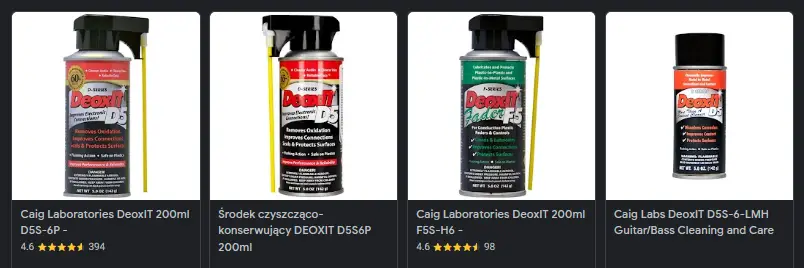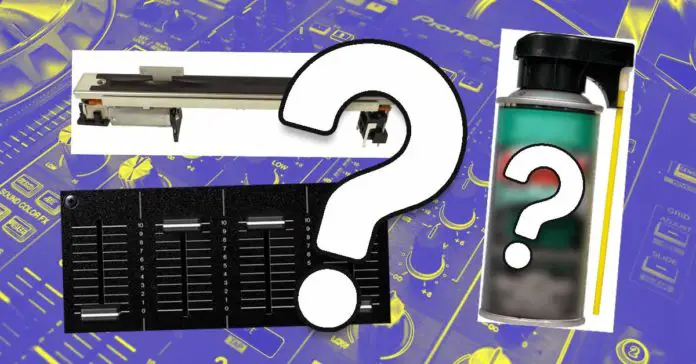Scratchy fader movement, faders glitching out? How to clean audio faders on a DJ mixer without taking it apart? We will go over a short process that can help you get your faders on old audio equipment moving smoothly again – no disassembly required!
- Why do you need to clean audio mixer faders?
- What do you need for the process
- What is a contact cleaner? (DeoxIT)
- Should you choose DeoxIT D or F – what’s the difference?
- Cleaning mixer faders – step by step walkthrough
- Important things to note – read carefully!
- Contact cleaner application video example
- Can you use q-tips for cleaning my mixer faders?
- My faders are still not working smoothly enough!
This web portal is supported by its readers, and is a part of the Amazon Services LLC Associates Program and the eBay Partner Network. When you buy using links on our site, we may earn an affiliate commission!
Why do you need to clean audio mixer faders?
Faders on any type of an audio mixer when not used for a long time can eventually become scratchy and dust-filled and you may experience weird phenomena such as scratching sound whilst moving the fader up or down or even uneven fader movement resulting in unwanted audio volume changes.
This is generally caused by dust particles that when slowly accumulating inside the fader coat the fader mechanism and on the factory applied lube and eventually limit the fader movements causing unusual phenomena during usage.
The effects of dirty or dusty faders can be anything from scratching sound during fader movement or general lack of smoothness during the process, up to in-software input glitches when it comes to MIDI controllers and direct volume jumps if we’re talking about equipment dealing with the analog audio signal.
What do you need for the process:
- A can of compressed air (Get it here!)
- A can of a contact cleaner of your choice – we recommend DeoxIT D5 for cleaning audio mixer faders (Get DeoxIT D5 here!)
- A portable vacuum cleaner (optional)
What is a contact cleaner? (DeoxIT)
A contact cleaner sometimes called a switch cleaner is a generally safe chemical agent used for the purpose of cleaning and maintaining conductive surfaces or electrical components with moving parts by reducing the contact resistance.
There are generally two types of contact cleaners – the ones that do not contain any additional lubricants (such cleaner is for example simple isopropyl alcohol) or the ones that contain appropriate lubricants that ensure smoother fader movement (such as DeoxIT D5).
Trusted contact cleaners containing safe lubricants like the DeoxIT D5 are the best for our purpose, as they will ensure the smooth movement of the slider when applied correctly.

Should you choose DeoxIT D or F – what’s the difference?
DeoxIT D5 is designed for safely cleaning and lubricating potentiometers and contacts so it’s perfect for cleaning mixer faders as those are in technical terms considered single linear slider potentiometers.
Alternatively you can also use the DeoxIT F100 / F5 – when the D series are general purpose cleaners and lubricants, F100 or F5 and all of the F series are lubricants made specifically for faders so applying them can ensure even smoother movement of the slider.
The main difference between D series and F series is that D series feature more of the contact cleaning agent while the F series contain more lubricant – both the D series and F series will work in our use case!
Get a can of DeoxIT F100 / F5 here!
You can also use any other kind of contact cleaner of your choice, however remember to make sure that it is safe to use on your device beforehand.
Cleaning mixer faders – step by step walkthrough:
- Step 1: Make sure your device is unplugged / it’s battery is disconnected before proceeding. Although it would probably fine either way its always a good practice to perform even minor maintenance this way to prevent risking accidental damage to your device.
- Step 2: Check if your fader caps come off easily by pulling the fader cap directly upwards, after pulling it up it should stay in your fingers and you should be able to take it off.
- If you are sure that your device’s faders are removable and the fader doesn’t come off give it a gentle wobble (left-right pivot motion) but be careful not to break off the fader’s slider (the pointy part on which the cap is mounted on).
- After you’ve successfully removed the fader caps place them somewhere beside your DJ mixer.
- Step 3: Remove all the bigger debris like hair or large dust particles using your fingers – this is really important so as not to push the larger particles inside the fader mechanism using compressed air in the next step.
- You can actually use a vacuum cleaner to make this part of the process easier. Turn on the vacuum cleaner and move the nozzle of the pipe (without any attachments) slowly throughout the whole fader. Be careful not to hit the surface of the mixer or the fader so as not to inflict any damage on the mixer’s plate or the fader itself.
- Step 4: Next, grab a can of compressed air (such as this one) and using a small tube that should come bundled with the can, blow air directly into the fader moving the tube from the top of the fader to the bottom of it. It’s best to do this in a few consecutive air blows rather than one continuous one.
- Important! – try to not let the flow of compressed air linger in one spot for more than approximately 1 second. Using compressed air generates freezing cold temperatures and moisture overtime so if you spray one single spot for longer you can risk damaging the electronics. The risk is low but it’s best to be cautious!
- Try to direct the air flow in a way that will push the dust outside of the fader rather than further inside it – don’t point the tube vertically – if you do so you might push the smaller dust particles deeper into the fader gap making them much harder to remove.
- Step 5: Grab your can of DeoxIT D5 (or other safe contact cleaner) and gently apply it to the fader gap starting from the top of the fader gap, going around the protruding slider (a part on which the fader gap was located before removal) and then finishing at the bottom of the gap.
- Step 6: After you’re done applying the contact cleaner on your mixer faders move the whole fader up and down in a quick manner a dozen of times repeatedly. This makes sure that the cleaning substance will be evenly distributed inside the fader’s chassis.
- Step 7: Remove the dust from the fader caps by spraying their bottom sides with compressed air if needed. Then wait a minute or so and place the fader caps back on the sliders.
Important things to note – read carefully!
- There is a really low chance that your audio mixer may feature non-removable mixer fader caps – if you are unsure about that its best to refer to your user manual or do a quick google search so that you don’t accidentally damage your fader mechanism during attempted fader cap removal.
- As we’ve pointed out when using compressed air ensure that you’re not blowing the cold air too long on one spot.
- Always consult the manual of the contact cleaner you’re using – some of other contact cleaners / lubricants may have different ways of applying or they may react with some delicate surfaces (for example rubber seals) – most of the time a shortened version of the manual will be printed on the lubricant can itself.
- In some cases just cleaning the fader gap from the outside won’t be enough to ensure proper functioning of your audio device, in those cases you should refer to other deep-cleaning guides that require disassembly of the fader mechanism, thorough cleanup of its parts and applying additional fader lubrication inside the device.

Contact cleaner application video example
This is a short video showing how you can correctly apply the contact cleaner to a fader on your audio device. In this example the fader cap is not removed and the fader has been pre-cleaned and dusted before the shown contact cleaner application.
Can you use q-tips for cleaning my mixer faders?
Yes, you can use q-tips / cotton swabs while removing the dust from the mixer faders in steps 3 and 4. Be careful however – standard q-tips can leave additional debris within the fader gap when too much pressure is applied and the cotton starts coming off the tip. Be gentle!
In further steps and after applying the lubricant/cleaner using a q-tip is not necessary. Moving the fader a dozen of times will be sufficient for the substance to spread through the mechanism.
My faders are still not working smoothly enough!
There is a chance that in your case you will need a thorougher clean and your device will have to be taken apart. Then you have to decide whether you will attempt to dissasemble the device by yourself or let the equipment service do that for you.

